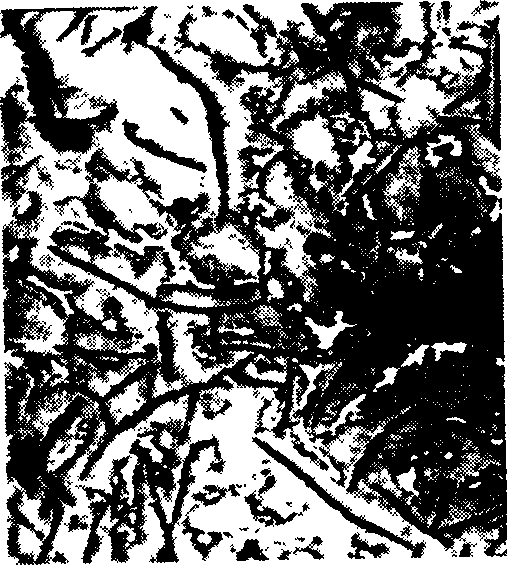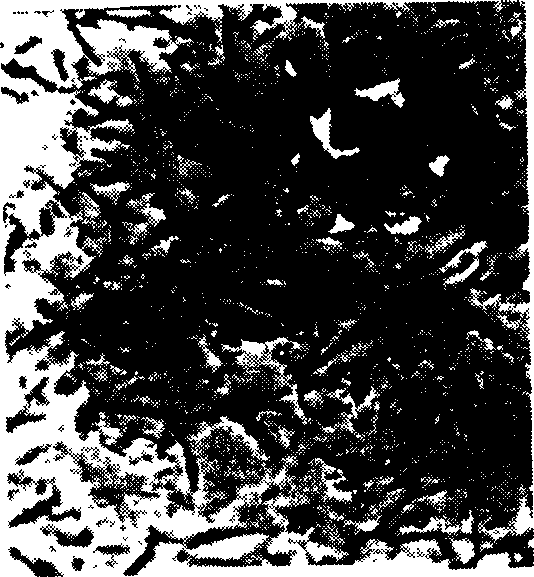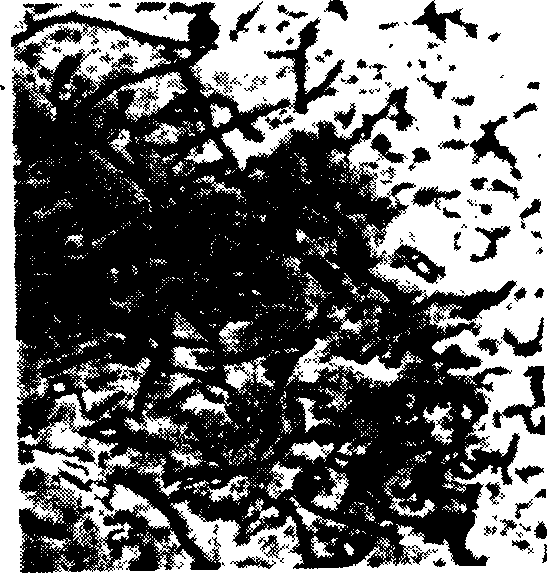Austenic cast iron with low Al and Ni content and medium Mn content and its production process
A process method and austenitic technology, which are applied to low-aluminum, low-nickel, medium-manganese, and austenitic cast iron and its technological fields, can solve the problems of easy oxidation, deteriorate alloy processing performance, affect casting quality, etc., and achieve low adding amount and reducing Inclusion of casting defects and good thermal stability
- Summary
- Abstract
- Description
- Claims
- Application Information
AI Technical Summary
Problems solved by technology
Method used
Image
Examples
Embodiment 1
[0029] Melting of low nickel, medium manganese austenitic cast iron. The chemical composition is: C3.70%, Si2.6%, Ni1.5%, Mn10.0%, Cu2.5%. Charges include ordinary pig iron, steel scrap (shavings), recycled charge, high-carbon ferromanganese, electrolytic nickel, 75 ferrosilicon and aluminum wire. Use a power frequency electric furnace to melt the charge. Raise the temperature to 1420°C and leave the oven. Add 0.7% 75% ferrosilicon and 0.25% aluminum wire into the ladle and stir evenly. Cast standard bending test bars and cylindrical castings of 130 (outer diameter) × 68 (inner diameter) × 200 (height) mm with sand molds. Cool to below 700°C to shake out sand and cool. As-cast metallographic microstructure see figure 1 . Type A graphite flakes are evenly distributed on the austenite matrix. The carbides are larger in size, in the shape of curved sheets, distributed between the austenite grains, and the amount is about 6%. It shows that the amount of inoculation in the ...
Embodiment 2
[0036] Melting of low nickel, medium manganese austenitic cast iron. The aluminum content is 0.3%, and the other chemical components and melting process are the same as in Example 1. Add 0.7% 75 ferrosilicon and 0.4% aluminum wire in the bag. As-cast metallographic structure (see figure 2 ) consists of fine A-type graphite flakes, austenite matrix and fine granular carbides. The number of carbides is 2.5%. It shows that increasing the amount of aluminum added in the ladle can effectively strengthen the inoculation effect and greatly reduce the number of carbides. Table 2 lists the alloy mechanical properties, thermal expansion coefficient and austenite thermal stability. The coefficient of thermal expansion is 18×10 -6 / °C, equivalent to ISO2896. The tensile strength and hardness also meet the requirements of ISO2896 (Edited by Ge Chenguang, Zhang Yunhua, and Zhu Wengao: The latest international casting standards. Compiled by the Secretariat of the National Casting Stan...
Embodiment 3
[0041] Melting of low nickel, medium manganese austenitic cast iron. The chemical composition is: C3.3%, Si2.5%, Mn8.3%, Ni4.0%, Cu2.7%, Al0.3%. Melting process is the same as embodiment 1. First add 05% 75 ferrosilicon into the ladle. Then, rush into 0.5% aluminum wire and 75 ferrosilicon with the molten iron flow for instant inoculation. Cast standard bending test bars and cylindrical castings of 130 (outer diameter) × 68 (inner diameter) × 200 (height) mm with sand molds. Cool to below 700°C to shake out sand and air cool. The fracture of the casting is thin, dense, free of inclusions and non-magnetic. As-cast metallographic structure (see image 3 ) consists of fine curved A-type graphite flakes, an austenite matrix and fine granular carbides. The amount of carbides is less than 1.5%, evenly distributed on the matrix, meeting the requirements of engine piston rings. Table 3 gives the alloy mechanical properties and thermal stability. This cast iron was kept at 580°...
PUM
| Property | Measurement | Unit |
|---|---|---|
| Thermal expansion coefficient | aaaaa | aaaaa |
| Tensile strength | aaaaa | aaaaa |
| Hardness | aaaaa | aaaaa |
Abstract
Description
Claims
Application Information
 Login to View More
Login to View More - R&D
- Intellectual Property
- Life Sciences
- Materials
- Tech Scout
- Unparalleled Data Quality
- Higher Quality Content
- 60% Fewer Hallucinations
Browse by: Latest US Patents, China's latest patents, Technical Efficacy Thesaurus, Application Domain, Technology Topic, Popular Technical Reports.
© 2025 PatSnap. All rights reserved.Legal|Privacy policy|Modern Slavery Act Transparency Statement|Sitemap|About US| Contact US: help@patsnap.com



